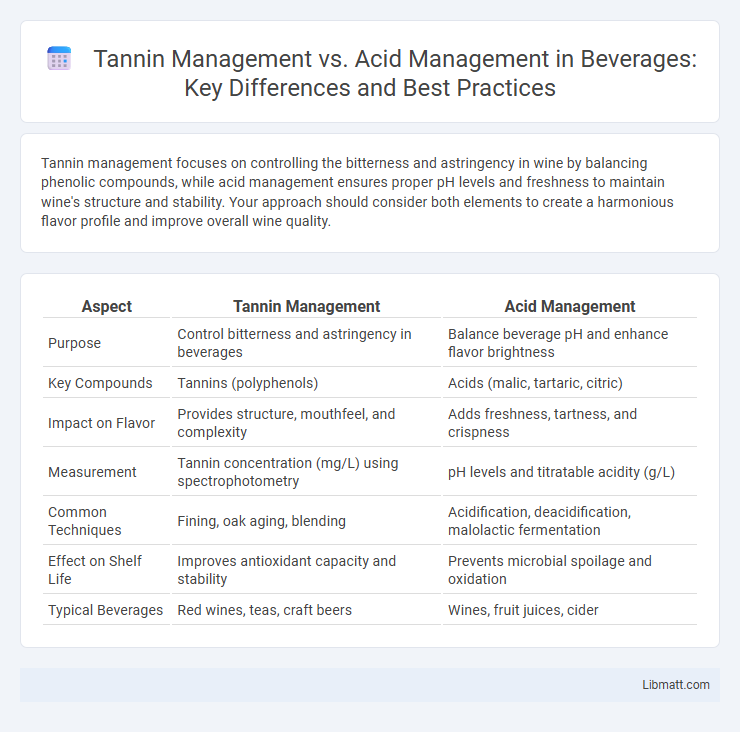Tannin management focuses on controlling the bitterness and astringency in wine by balancing phenolic compounds, while acid management ensures proper pH levels and freshness to maintain wine's structure and stability. Your approach should consider both elements to create a harmonious flavor profile and improve overall wine quality.
Table of Comparison
| Aspect | Tannin Management | Acid Management |
|---|---|---|
| Purpose | Control bitterness and astringency in beverages | Balance beverage pH and enhance flavor brightness |
| Key Compounds | Tannins (polyphenols) | Acids (malic, tartaric, citric) |
| Impact on Flavor | Provides structure, mouthfeel, and complexity | Adds freshness, tartness, and crispness |
| Measurement | Tannin concentration (mg/L) using spectrophotometry | pH levels and titratable acidity (g/L) |
| Common Techniques | Fining, oak aging, blending | Acidification, deacidification, malolactic fermentation |
| Effect on Shelf Life | Improves antioxidant capacity and stability | Prevents microbial spoilage and oxidation |
| Typical Beverages | Red wines, teas, craft beers | Wines, fruit juices, cider |
Understanding Tannin and Acid in Winemaking
Tannin management in winemaking involves controlling the extraction and integration of phenolic compounds that contribute to a wine's structure, astringency, and aging potential, while acid management focuses on balancing the wine's pH and acidity levels to enhance freshness, stability, and flavor profile. Understanding the interplay between tannins and acids is crucial for achieving harmony and complexity, as tannins can soften the perception of acidity and acids can brighten the overall palate. Your skillful adjustment of both components during fermentation and aging directly impacts the wine's taste, texture, and longevity.
The Role of Tannins in Wine Structure
Tannins play a crucial role in wine structure by providing bitterness, astringency, and contributing to the wine's aging potential through their interaction with proteins and polysaccharides. Effective tannin management involves controlling extraction during fermentation and aging to balance texture and mouthfeel without overpowering the wine's acidity. Acid management, while essential for freshness and stability, complements tannin structure by enhancing the perception of balance and overall harmony in the wine.
The Influence of Acidity on Wine Balance
Acidity plays a critical role in balancing tannin perception and overall wine structure by enhancing freshness and reducing bitterness. Proper acid management can soften aggressive tannins, creating a smoother mouthfeel and improving the wine's aging potential. Optimal acid-tannin harmony contributes to a well-rounded, vibrant wine profile that appeals to sensory balance and complexity.
Key Differences: Tannin Management vs. Acid Management
Tannin management primarily targets the regulation of phenolic compounds that influence a wine's texture, bitterness, and astringency, whereas acid management focuses on balancing the wine's pH and total acidity to enhance freshness and stability. Tannin adjustment involves techniques like maceration timing, oak aging, and fining agents to soften or preserve structure, while acid management employs acid additions, malolactic fermentation, and cold stabilization to control tartness and microbial stability. The distinct objectives of tannin and acid management require tailored approaches to optimize wine sensory profiles and aging potential.
Techniques for Controlling Tannin Levels
Techniques for controlling tannin levels in winemaking include selective grape harvesting, employing oak aging, and using fining agents such as egg whites or gelatin to bind and precipitate excess tannins. Acid management involves adjusting pH through malolactic fermentation or acid additions like tartaric or citric acid to balance wine's structure and freshness. Optimizing both tannin and acid profiles ensures harmonious mouthfeel, flavor stability, and aging potential in the final wine.
Methods for Adjusting Acidity
Methods for adjusting acidity in wine involve techniques such as acidification by adding tartaric acid or deacidification through malolactic fermentation or calcium carbonate addition. Tannin management focuses on controlling phenolic extraction through maceration time, temperature, and oak aging rather than directly modifying acidity. Precise acid adjustments optimize microbial stability and balance while tannin adjustments enhance mouthfeel and structure without altering pH levels.
Impact of Tannin and Acid on Wine Aging
Tannin management significantly influences wine aging by providing structure, longevity, and complexity through phenolic compounds that interact with oxygen to develop flavor profiles over time. Acid management maintains wine stability and freshness, preventing microbial spoilage and preserving bright, vibrant taste characteristics during maturation. Your strategic balance of tannins and acids ensures optimal wine evolution, enhancing aromatic depth and textural harmony throughout aging.
Sensory Effects: Tannin vs. Acid Perception
Tannin management significantly influences the astringency, bitterness, and mouth-coating sensations in wine, enhancing texture and complexity, while acid management primarily affects freshness, brightness, and perceived crispness. Balanced tannin levels contribute to a smoother, more structured palate, whereas controlled acidity ensures vibrancy and lifts fruit flavors, directly shaping your wine's overall sensory profile. Optimal interplay between tannins and acids refines the tactile and flavor perception, creating harmony between richness and liveliness in each sip.
Challenges in Balancing Tannin and Acidity
Balancing tannin and acidity in winemaking presents challenges due to their distinct chemical properties and impact on flavor profile; excessive tannins can cause bitterness and astringency, while high acidity may lead to sharpness and imbalance. Effective management requires precise control during fermentation and aging, using techniques such as adjusting maceration time and selecting malolactic fermentation to soften acids and integrate tannins. Monitoring pH levels and acidity through analytical methods ensures optimal harmony, improving the wine's structure and mouthfeel.
Best Practices for Integrated Tannin and Acid Management
Effective integrated tannin and acid management in winemaking requires precise monitoring of pH and titratable acidity alongside regular sensory evaluations to achieve optimal balance. Employing techniques such as controlled maceration, timely acid adjustments using tartaric or malic acid, and selective oak aging helps harmonize tannin structure with acidity levels. Advanced tools like spectrophotometric tannin analysis and acid titration kits support consistency in flavor profile and wine stability throughout fermentation and aging.
Tannin management vs acid management Infographic

 libmatt.com
libmatt.com